Taxation Law Assignment: Income Tax, Capital Gains, and Case Analysis
VerifiedAdded on 2021/06/17
|11
|2182
|39
Homework Assignment
AI Summary
This taxation law assignment solution addresses several key issues related to income tax and capital gains tax (CGT) in Australia. It examines the taxability of income derived from services, including media interviews and book publications, referencing relevant legislation such as the ITAA 1997 and case law like FCT v Scott and FCT v Brent. The assignment also explores the tax treatment of interest income from loans and the implications of selling assets, including land and buildings, under CGT rules. Furthermore, the solution analyzes scenarios involving property sales, providing calculations for capital gains and losses, and considers the tax implications for both individuals and companies. The document incorporates references to supporting legal principles and case precedents to justify its conclusions.
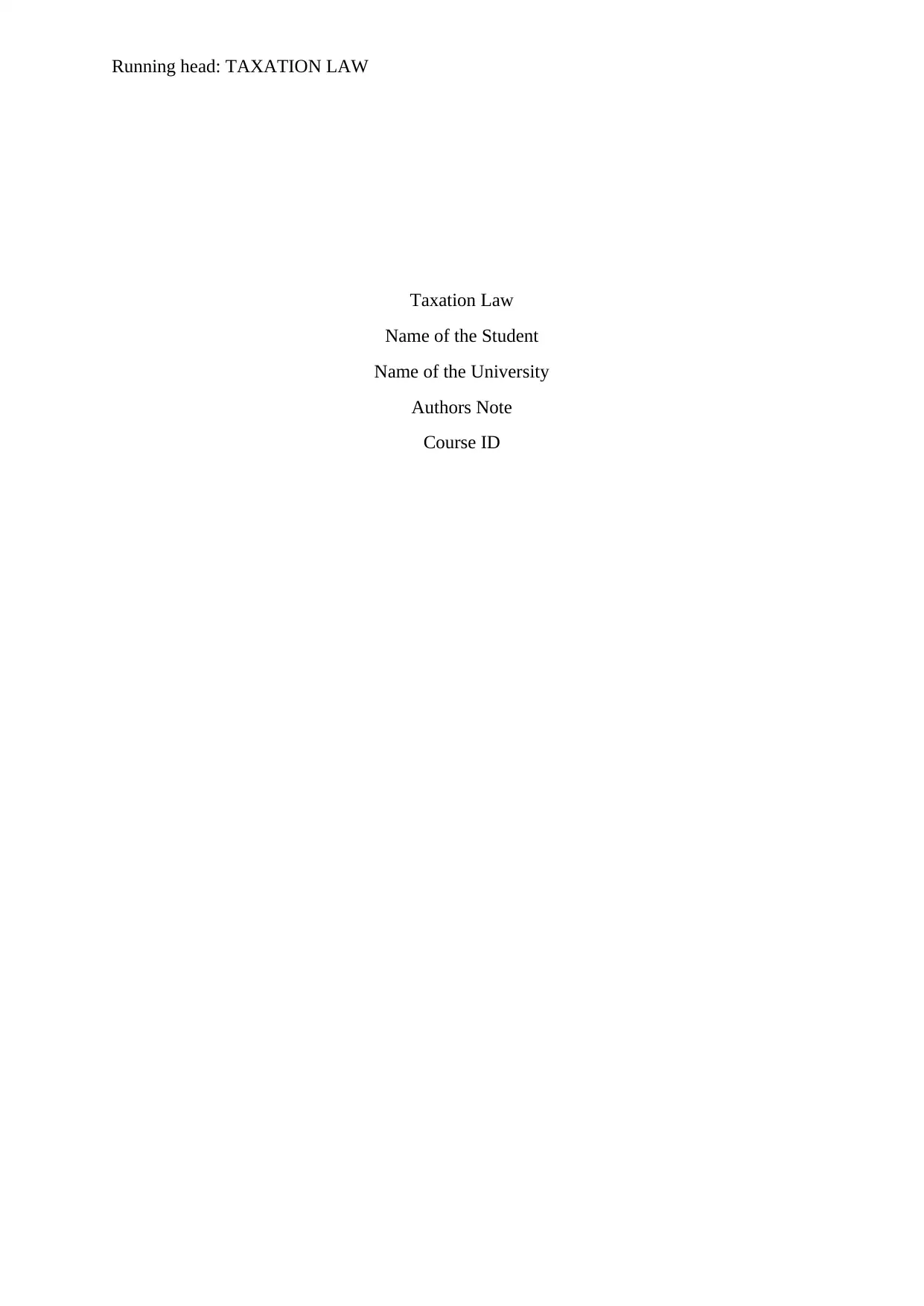
Running head: TAXATION LAW
Taxation Law
Name of the Student
Name of the University
Authors Note
Course ID
Taxation Law
Name of the Student
Name of the University
Authors Note
Course ID
Paraphrase This Document
Need a fresh take? Get an instant paraphrase of this document with our AI Paraphraser
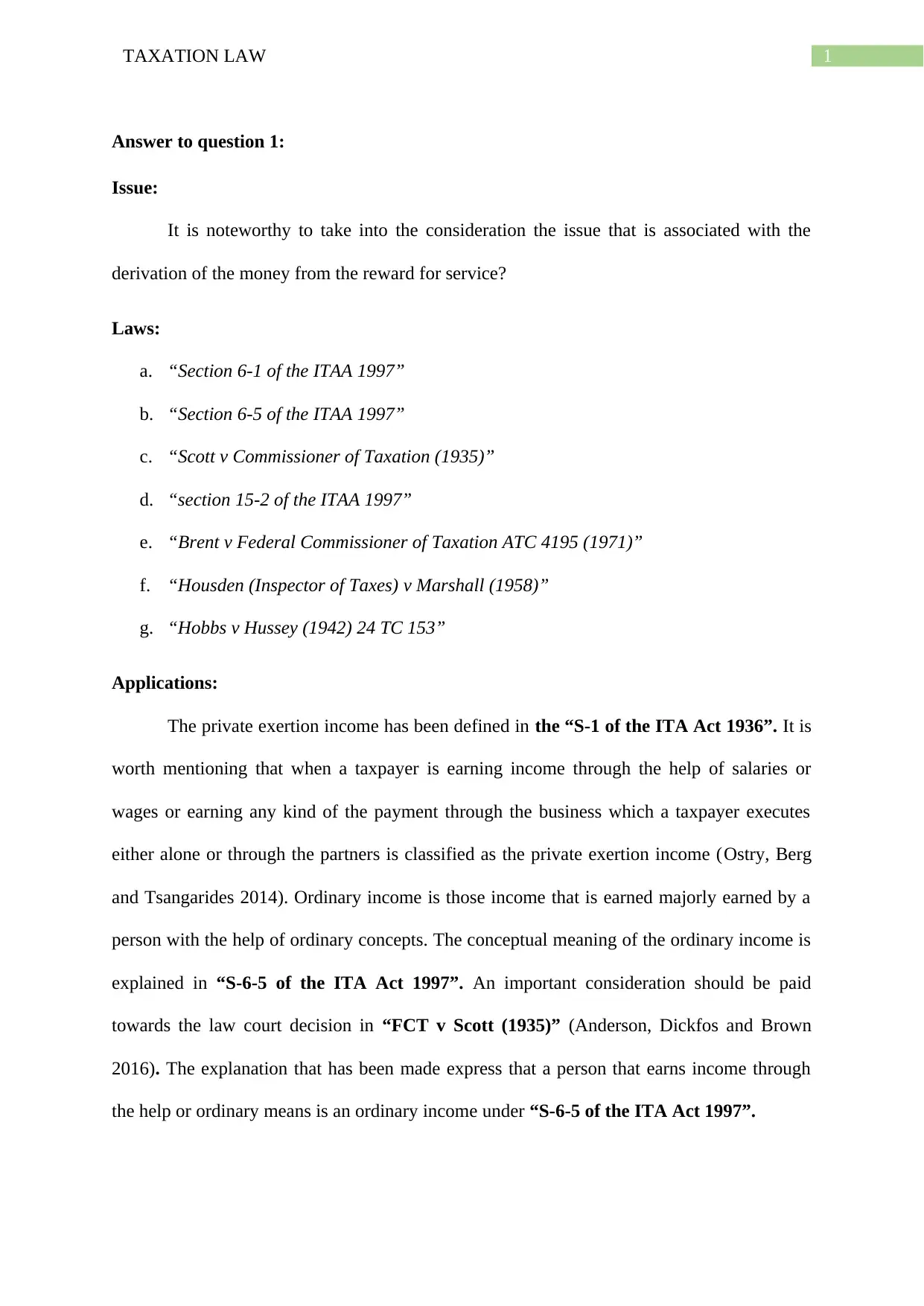
1TAXATION LAW
Answer to question 1:
Issue:
It is noteworthy to take into the consideration the issue that is associated with the
derivation of the money from the reward for service?
Laws:
a. “Section 6-1 of the ITAA 1997”
b. “Section 6-5 of the ITAA 1997”
c. “Scott v Commissioner of Taxation (1935)”
d. “section 15-2 of the ITAA 1997”
e. “Brent v Federal Commissioner of Taxation ATC 4195 (1971)”
f. “Housden (Inspector of Taxes) v Marshall (1958)”
g. “Hobbs v Hussey (1942) 24 TC 153”
Applications:
The private exertion income has been defined in the “S-1 of the ITA Act 1936”. It is
worth mentioning that when a taxpayer is earning income through the help of salaries or
wages or earning any kind of the payment through the business which a taxpayer executes
either alone or through the partners is classified as the private exertion income (Ostry, Berg
and Tsangarides 2014). Ordinary income is those income that is earned majorly earned by a
person with the help of ordinary concepts. The conceptual meaning of the ordinary income is
explained in “S-6-5 of the ITA Act 1997”. An important consideration should be paid
towards the law court decision in “FCT v Scott (1935)” (Anderson, Dickfos and Brown
2016). The explanation that has been made express that a person that earns income through
the help or ordinary means is an ordinary income under “S-6-5 of the ITA Act 1997”.
Answer to question 1:
Issue:
It is noteworthy to take into the consideration the issue that is associated with the
derivation of the money from the reward for service?
Laws:
a. “Section 6-1 of the ITAA 1997”
b. “Section 6-5 of the ITAA 1997”
c. “Scott v Commissioner of Taxation (1935)”
d. “section 15-2 of the ITAA 1997”
e. “Brent v Federal Commissioner of Taxation ATC 4195 (1971)”
f. “Housden (Inspector of Taxes) v Marshall (1958)”
g. “Hobbs v Hussey (1942) 24 TC 153”
Applications:
The private exertion income has been defined in the “S-1 of the ITA Act 1936”. It is
worth mentioning that when a taxpayer is earning income through the help of salaries or
wages or earning any kind of the payment through the business which a taxpayer executes
either alone or through the partners is classified as the private exertion income (Ostry, Berg
and Tsangarides 2014). Ordinary income is those income that is earned majorly earned by a
person with the help of ordinary concepts. The conceptual meaning of the ordinary income is
explained in “S-6-5 of the ITA Act 1997”. An important consideration should be paid
towards the law court decision in “FCT v Scott (1935)” (Anderson, Dickfos and Brown
2016). The explanation that has been made express that a person that earns income through
the help or ordinary means is an ordinary income under “S-6-5 of the ITA Act 1997”.
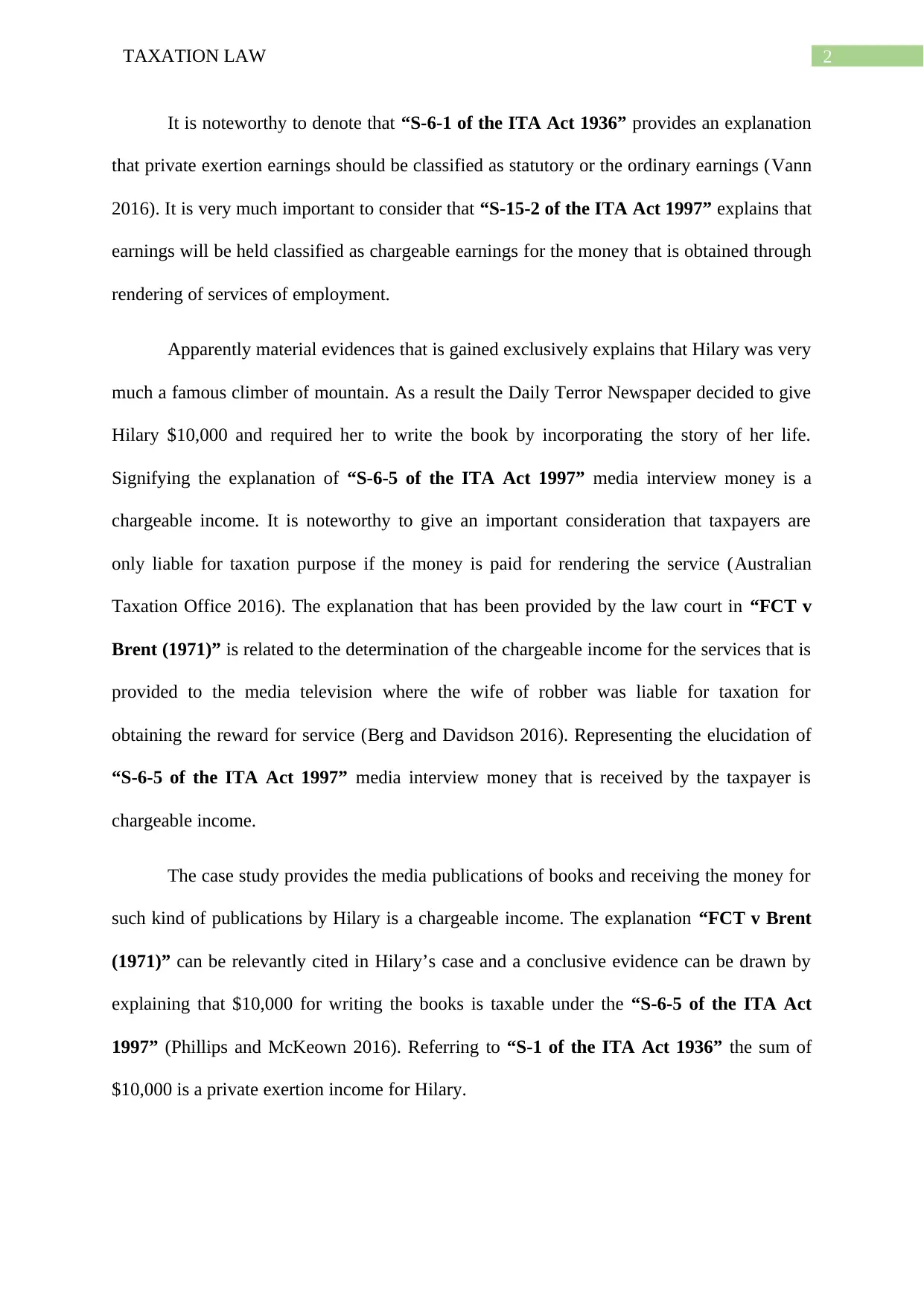
2TAXATION LAW
It is noteworthy to denote that “S-6-1 of the ITA Act 1936” provides an explanation
that private exertion earnings should be classified as statutory or the ordinary earnings (Vann
2016). It is very much important to consider that “S-15-2 of the ITA Act 1997” explains that
earnings will be held classified as chargeable earnings for the money that is obtained through
rendering of services of employment.
Apparently material evidences that is gained exclusively explains that Hilary was very
much a famous climber of mountain. As a result the Daily Terror Newspaper decided to give
Hilary $10,000 and required her to write the book by incorporating the story of her life.
Signifying the explanation of “S-6-5 of the ITA Act 1997” media interview money is a
chargeable income. It is noteworthy to give an important consideration that taxpayers are
only liable for taxation purpose if the money is paid for rendering the service (Australian
Taxation Office 2016). The explanation that has been provided by the law court in “FCT v
Brent (1971)” is related to the determination of the chargeable income for the services that is
provided to the media television where the wife of robber was liable for taxation for
obtaining the reward for service (Berg and Davidson 2016). Representing the elucidation of
“S-6-5 of the ITA Act 1997” media interview money that is received by the taxpayer is
chargeable income.
The case study provides the media publications of books and receiving the money for
such kind of publications by Hilary is a chargeable income. The explanation “FCT v Brent
(1971)” can be relevantly cited in Hilary’s case and a conclusive evidence can be drawn by
explaining that $10,000 for writing the books is taxable under the “S-6-5 of the ITA Act
1997” (Phillips and McKeown 2016). Referring to “S-1 of the ITA Act 1936” the sum of
$10,000 is a private exertion income for Hilary.
It is noteworthy to denote that “S-6-1 of the ITA Act 1936” provides an explanation
that private exertion earnings should be classified as statutory or the ordinary earnings (Vann
2016). It is very much important to consider that “S-15-2 of the ITA Act 1997” explains that
earnings will be held classified as chargeable earnings for the money that is obtained through
rendering of services of employment.
Apparently material evidences that is gained exclusively explains that Hilary was very
much a famous climber of mountain. As a result the Daily Terror Newspaper decided to give
Hilary $10,000 and required her to write the book by incorporating the story of her life.
Signifying the explanation of “S-6-5 of the ITA Act 1997” media interview money is a
chargeable income. It is noteworthy to give an important consideration that taxpayers are
only liable for taxation purpose if the money is paid for rendering the service (Australian
Taxation Office 2016). The explanation that has been provided by the law court in “FCT v
Brent (1971)” is related to the determination of the chargeable income for the services that is
provided to the media television where the wife of robber was liable for taxation for
obtaining the reward for service (Berg and Davidson 2016). Representing the elucidation of
“S-6-5 of the ITA Act 1997” media interview money that is received by the taxpayer is
chargeable income.
The case study provides the media publications of books and receiving the money for
such kind of publications by Hilary is a chargeable income. The explanation “FCT v Brent
(1971)” can be relevantly cited in Hilary’s case and a conclusive evidence can be drawn by
explaining that $10,000 for writing the books is taxable under the “S-6-5 of the ITA Act
1997” (Phillips and McKeown 2016). Referring to “S-1 of the ITA Act 1936” the sum of
$10,000 is a private exertion income for Hilary.
⊘ This is a preview!⊘
Do you want full access?
Subscribe today to unlock all pages.

Trusted by 1+ million students worldwide
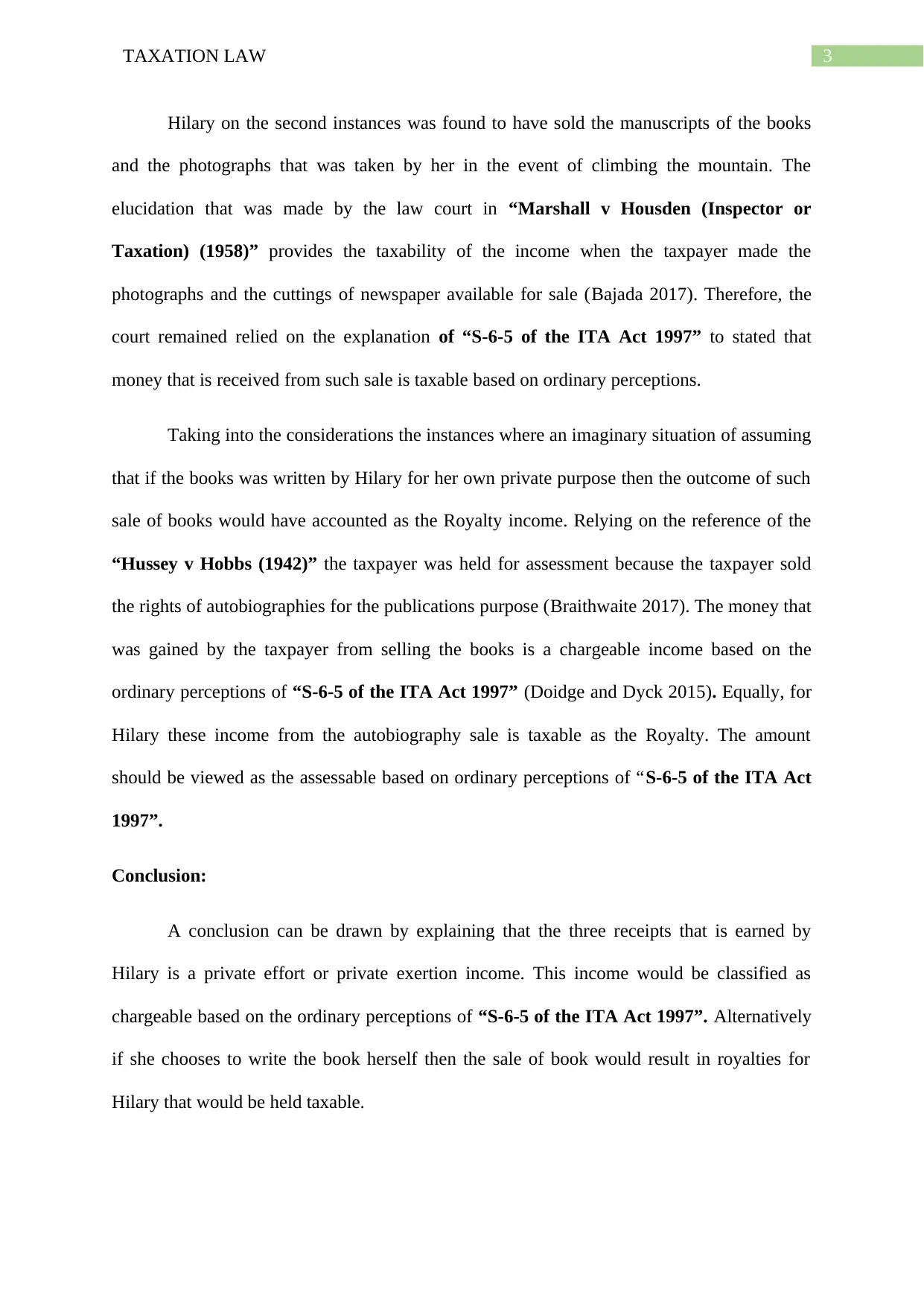
3TAXATION LAW
Hilary on the second instances was found to have sold the manuscripts of the books
and the photographs that was taken by her in the event of climbing the mountain. The
elucidation that was made by the law court in “Marshall v Housden (Inspector or
Taxation) (1958)” provides the taxability of the income when the taxpayer made the
photographs and the cuttings of newspaper available for sale (Bajada 2017). Therefore, the
court remained relied on the explanation of “S-6-5 of the ITA Act 1997” to stated that
money that is received from such sale is taxable based on ordinary perceptions.
Taking into the considerations the instances where an imaginary situation of assuming
that if the books was written by Hilary for her own private purpose then the outcome of such
sale of books would have accounted as the Royalty income. Relying on the reference of the
“Hussey v Hobbs (1942)” the taxpayer was held for assessment because the taxpayer sold
the rights of autobiographies for the publications purpose (Braithwaite 2017). The money that
was gained by the taxpayer from selling the books is a chargeable income based on the
ordinary perceptions of “S-6-5 of the ITA Act 1997” (Doidge and Dyck 2015). Equally, for
Hilary these income from the autobiography sale is taxable as the Royalty. The amount
should be viewed as the assessable based on ordinary perceptions of “S-6-5 of the ITA Act
1997”.
Conclusion:
A conclusion can be drawn by explaining that the three receipts that is earned by
Hilary is a private effort or private exertion income. This income would be classified as
chargeable based on the ordinary perceptions of “S-6-5 of the ITA Act 1997”. Alternatively
if she chooses to write the book herself then the sale of book would result in royalties for
Hilary that would be held taxable.
Hilary on the second instances was found to have sold the manuscripts of the books
and the photographs that was taken by her in the event of climbing the mountain. The
elucidation that was made by the law court in “Marshall v Housden (Inspector or
Taxation) (1958)” provides the taxability of the income when the taxpayer made the
photographs and the cuttings of newspaper available for sale (Bajada 2017). Therefore, the
court remained relied on the explanation of “S-6-5 of the ITA Act 1997” to stated that
money that is received from such sale is taxable based on ordinary perceptions.
Taking into the considerations the instances where an imaginary situation of assuming
that if the books was written by Hilary for her own private purpose then the outcome of such
sale of books would have accounted as the Royalty income. Relying on the reference of the
“Hussey v Hobbs (1942)” the taxpayer was held for assessment because the taxpayer sold
the rights of autobiographies for the publications purpose (Braithwaite 2017). The money that
was gained by the taxpayer from selling the books is a chargeable income based on the
ordinary perceptions of “S-6-5 of the ITA Act 1997” (Doidge and Dyck 2015). Equally, for
Hilary these income from the autobiography sale is taxable as the Royalty. The amount
should be viewed as the assessable based on ordinary perceptions of “S-6-5 of the ITA Act
1997”.
Conclusion:
A conclusion can be drawn by explaining that the three receipts that is earned by
Hilary is a private effort or private exertion income. This income would be classified as
chargeable based on the ordinary perceptions of “S-6-5 of the ITA Act 1997”. Alternatively
if she chooses to write the book herself then the sale of book would result in royalties for
Hilary that would be held taxable.
Paraphrase This Document
Need a fresh take? Get an instant paraphrase of this document with our AI Paraphraser
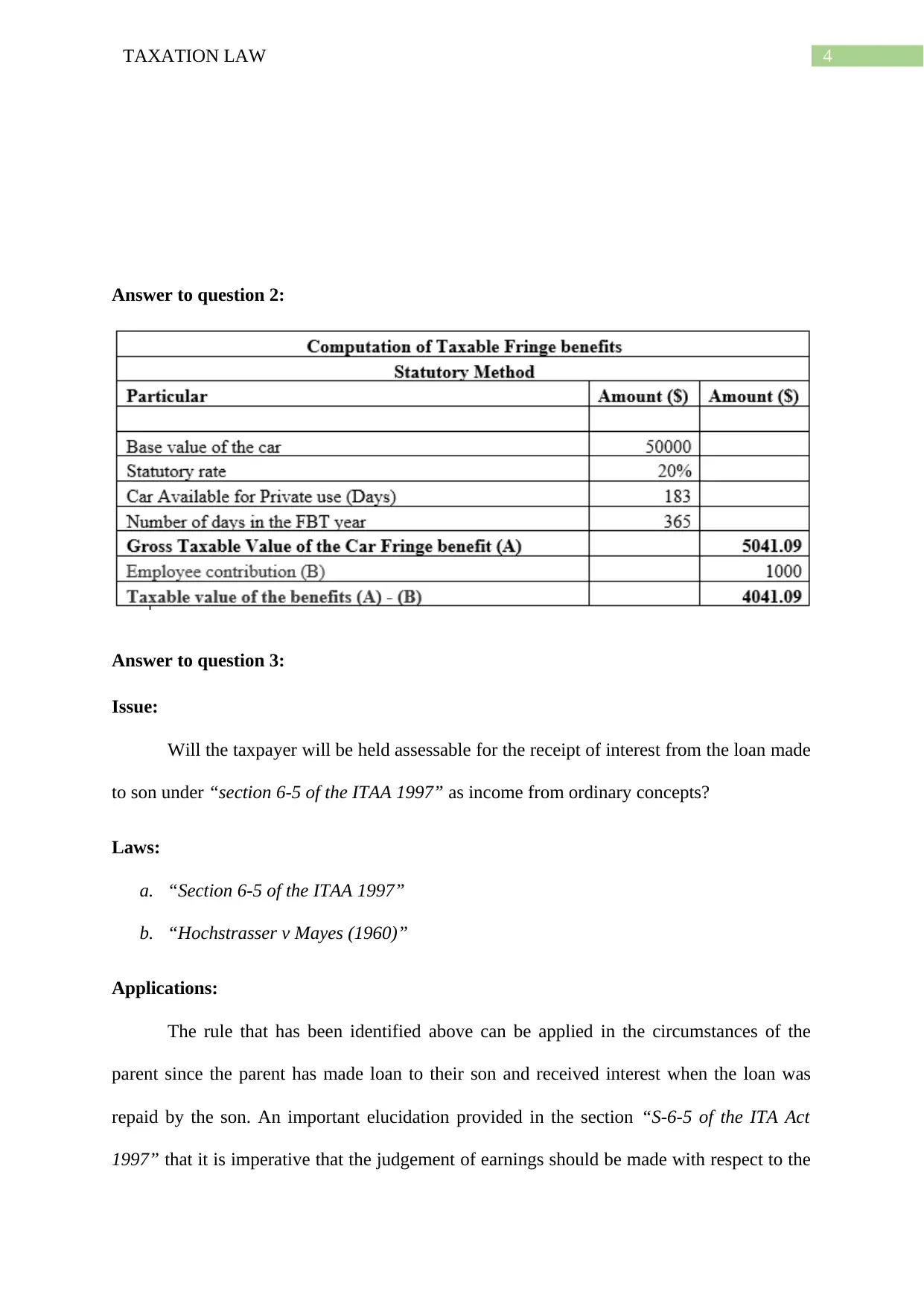
4TAXATION LAW
Answer to question 2:
Answer to question 3:
Issue:
Will the taxpayer will be held assessable for the receipt of interest from the loan made
to son under “section 6-5 of the ITAA 1997” as income from ordinary concepts?
Laws:
a. “Section 6-5 of the ITAA 1997”
b. “Hochstrasser v Mayes (1960)”
Applications:
The rule that has been identified above can be applied in the circumstances of the
parent since the parent has made loan to their son and received interest when the loan was
repaid by the son. An important elucidation provided in the section “S-6-5 of the ITA Act
1997” that it is imperative that the judgement of earnings should be made with respect to the
Answer to question 2:
Answer to question 3:
Issue:
Will the taxpayer will be held assessable for the receipt of interest from the loan made
to son under “section 6-5 of the ITAA 1997” as income from ordinary concepts?
Laws:
a. “Section 6-5 of the ITAA 1997”
b. “Hochstrasser v Mayes (1960)”
Applications:
The rule that has been identified above can be applied in the circumstances of the
parent since the parent has made loan to their son and received interest when the loan was
repaid by the son. An important elucidation provided in the section “S-6-5 of the ITA Act
1997” that it is imperative that the judgement of earnings should be made with respect to the
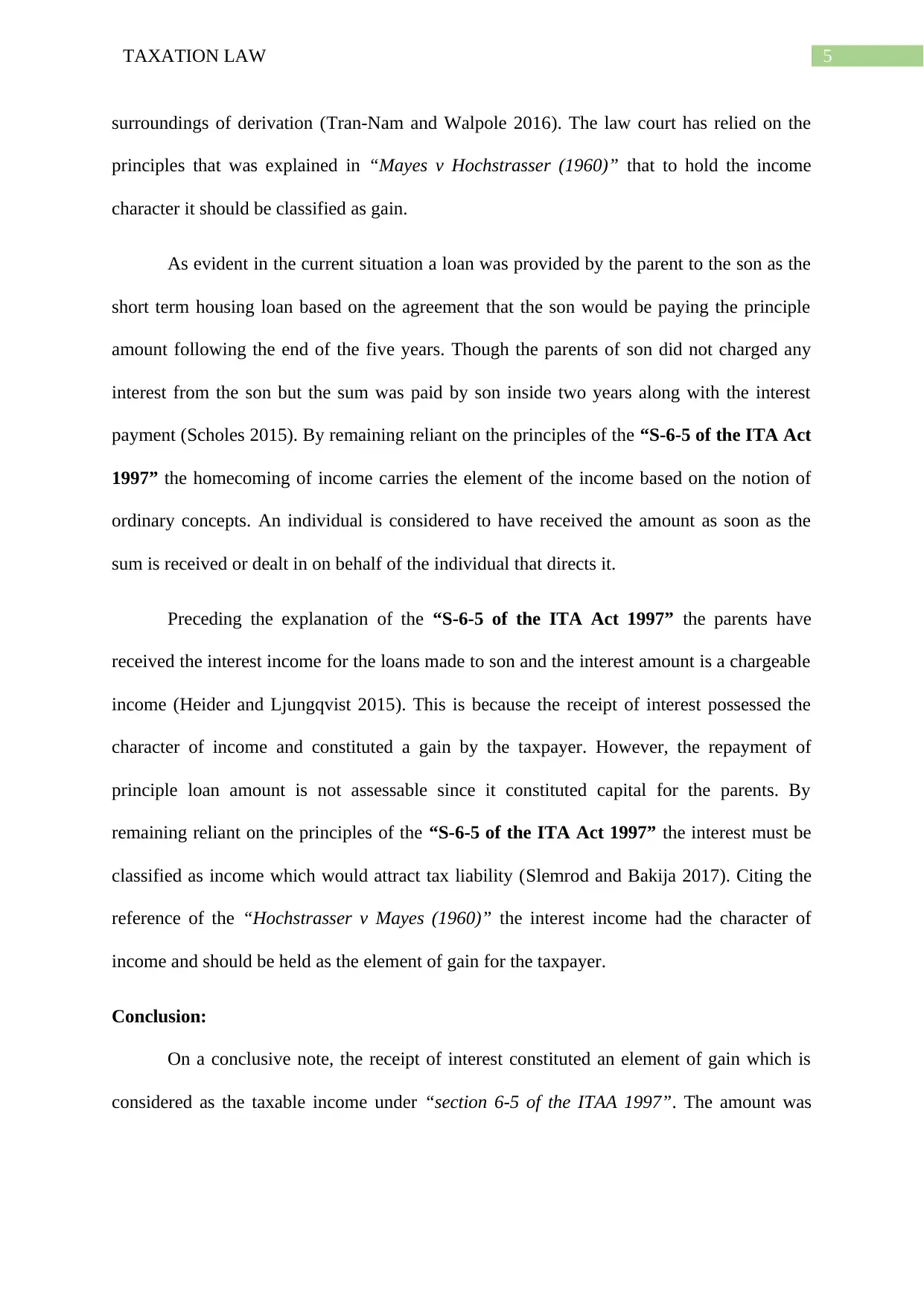
5TAXATION LAW
surroundings of derivation (Tran-Nam and Walpole 2016). The law court has relied on the
principles that was explained in “Mayes v Hochstrasser (1960)” that to hold the income
character it should be classified as gain.
As evident in the current situation a loan was provided by the parent to the son as the
short term housing loan based on the agreement that the son would be paying the principle
amount following the end of the five years. Though the parents of son did not charged any
interest from the son but the sum was paid by son inside two years along with the interest
payment (Scholes 2015). By remaining reliant on the principles of the “S-6-5 of the ITA Act
1997” the homecoming of income carries the element of the income based on the notion of
ordinary concepts. An individual is considered to have received the amount as soon as the
sum is received or dealt in on behalf of the individual that directs it.
Preceding the explanation of the “S-6-5 of the ITA Act 1997” the parents have
received the interest income for the loans made to son and the interest amount is a chargeable
income (Heider and Ljungqvist 2015). This is because the receipt of interest possessed the
character of income and constituted a gain by the taxpayer. However, the repayment of
principle loan amount is not assessable since it constituted capital for the parents. By
remaining reliant on the principles of the “S-6-5 of the ITA Act 1997” the interest must be
classified as income which would attract tax liability (Slemrod and Bakija 2017). Citing the
reference of the “Hochstrasser v Mayes (1960)” the interest income had the character of
income and should be held as the element of gain for the taxpayer.
Conclusion:
On a conclusive note, the receipt of interest constituted an element of gain which is
considered as the taxable income under “section 6-5 of the ITAA 1997”. The amount was
surroundings of derivation (Tran-Nam and Walpole 2016). The law court has relied on the
principles that was explained in “Mayes v Hochstrasser (1960)” that to hold the income
character it should be classified as gain.
As evident in the current situation a loan was provided by the parent to the son as the
short term housing loan based on the agreement that the son would be paying the principle
amount following the end of the five years. Though the parents of son did not charged any
interest from the son but the sum was paid by son inside two years along with the interest
payment (Scholes 2015). By remaining reliant on the principles of the “S-6-5 of the ITA Act
1997” the homecoming of income carries the element of the income based on the notion of
ordinary concepts. An individual is considered to have received the amount as soon as the
sum is received or dealt in on behalf of the individual that directs it.
Preceding the explanation of the “S-6-5 of the ITA Act 1997” the parents have
received the interest income for the loans made to son and the interest amount is a chargeable
income (Heider and Ljungqvist 2015). This is because the receipt of interest possessed the
character of income and constituted a gain by the taxpayer. However, the repayment of
principle loan amount is not assessable since it constituted capital for the parents. By
remaining reliant on the principles of the “S-6-5 of the ITA Act 1997” the interest must be
classified as income which would attract tax liability (Slemrod and Bakija 2017). Citing the
reference of the “Hochstrasser v Mayes (1960)” the interest income had the character of
income and should be held as the element of gain for the taxpayer.
Conclusion:
On a conclusive note, the receipt of interest constituted an element of gain which is
considered as the taxable income under “section 6-5 of the ITAA 1997”. The amount was
⊘ This is a preview!⊘
Do you want full access?
Subscribe today to unlock all pages.

Trusted by 1+ million students worldwide
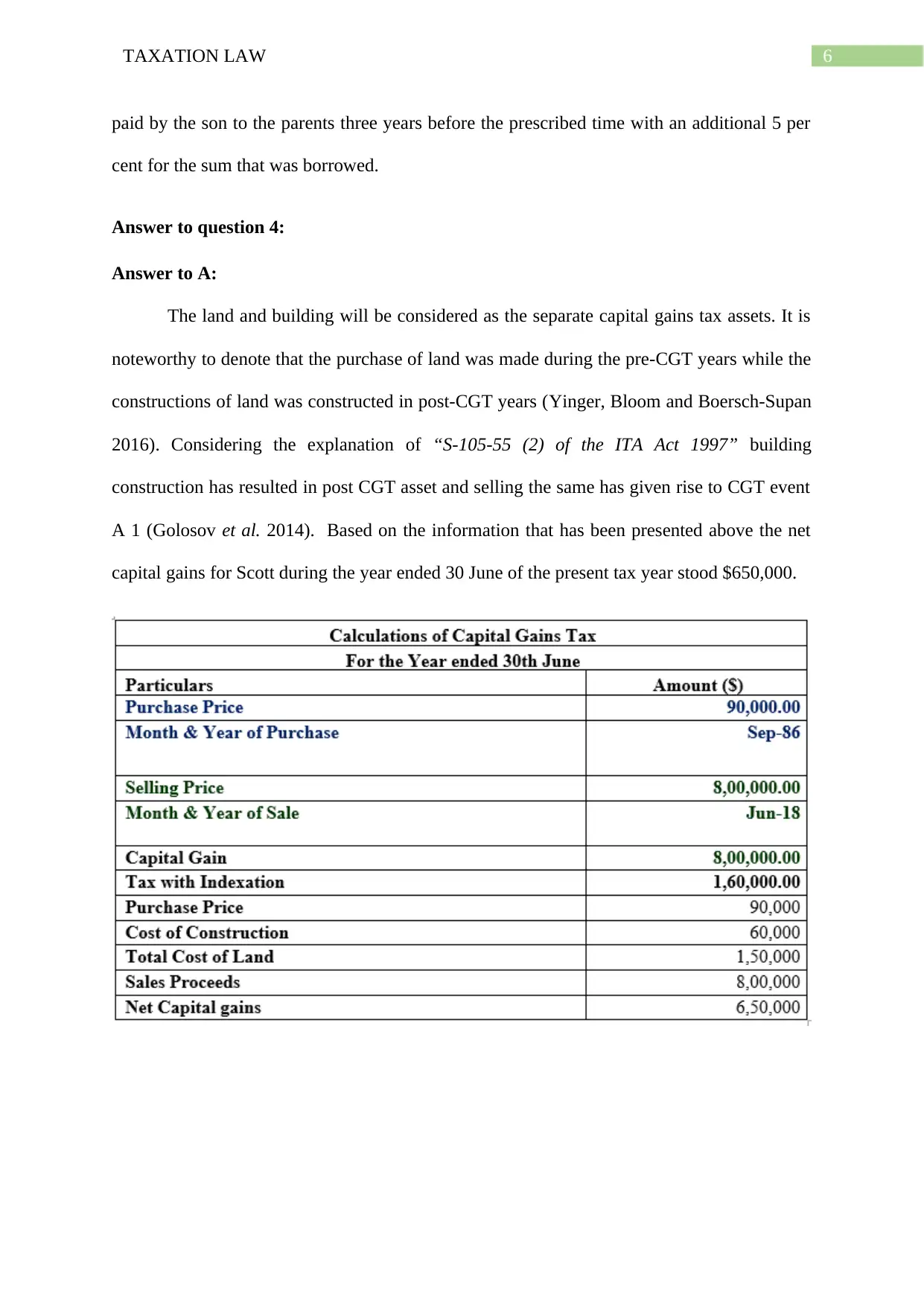
6TAXATION LAW
paid by the son to the parents three years before the prescribed time with an additional 5 per
cent for the sum that was borrowed.
Answer to question 4:
Answer to A:
The land and building will be considered as the separate capital gains tax assets. It is
noteworthy to denote that the purchase of land was made during the pre-CGT years while the
constructions of land was constructed in post-CGT years (Yinger, Bloom and Boersch-Supan
2016). Considering the explanation of “S-105-55 (2) of the ITA Act 1997” building
construction has resulted in post CGT asset and selling the same has given rise to CGT event
A 1 (Golosov et al. 2014). Based on the information that has been presented above the net
capital gains for Scott during the year ended 30 June of the present tax year stood $650,000.
paid by the son to the parents three years before the prescribed time with an additional 5 per
cent for the sum that was borrowed.
Answer to question 4:
Answer to A:
The land and building will be considered as the separate capital gains tax assets. It is
noteworthy to denote that the purchase of land was made during the pre-CGT years while the
constructions of land was constructed in post-CGT years (Yinger, Bloom and Boersch-Supan
2016). Considering the explanation of “S-105-55 (2) of the ITA Act 1997” building
construction has resulted in post CGT asset and selling the same has given rise to CGT event
A 1 (Golosov et al. 2014). Based on the information that has been presented above the net
capital gains for Scott during the year ended 30 June of the present tax year stood $650,000.
Paraphrase This Document
Need a fresh take? Get an instant paraphrase of this document with our AI Paraphraser
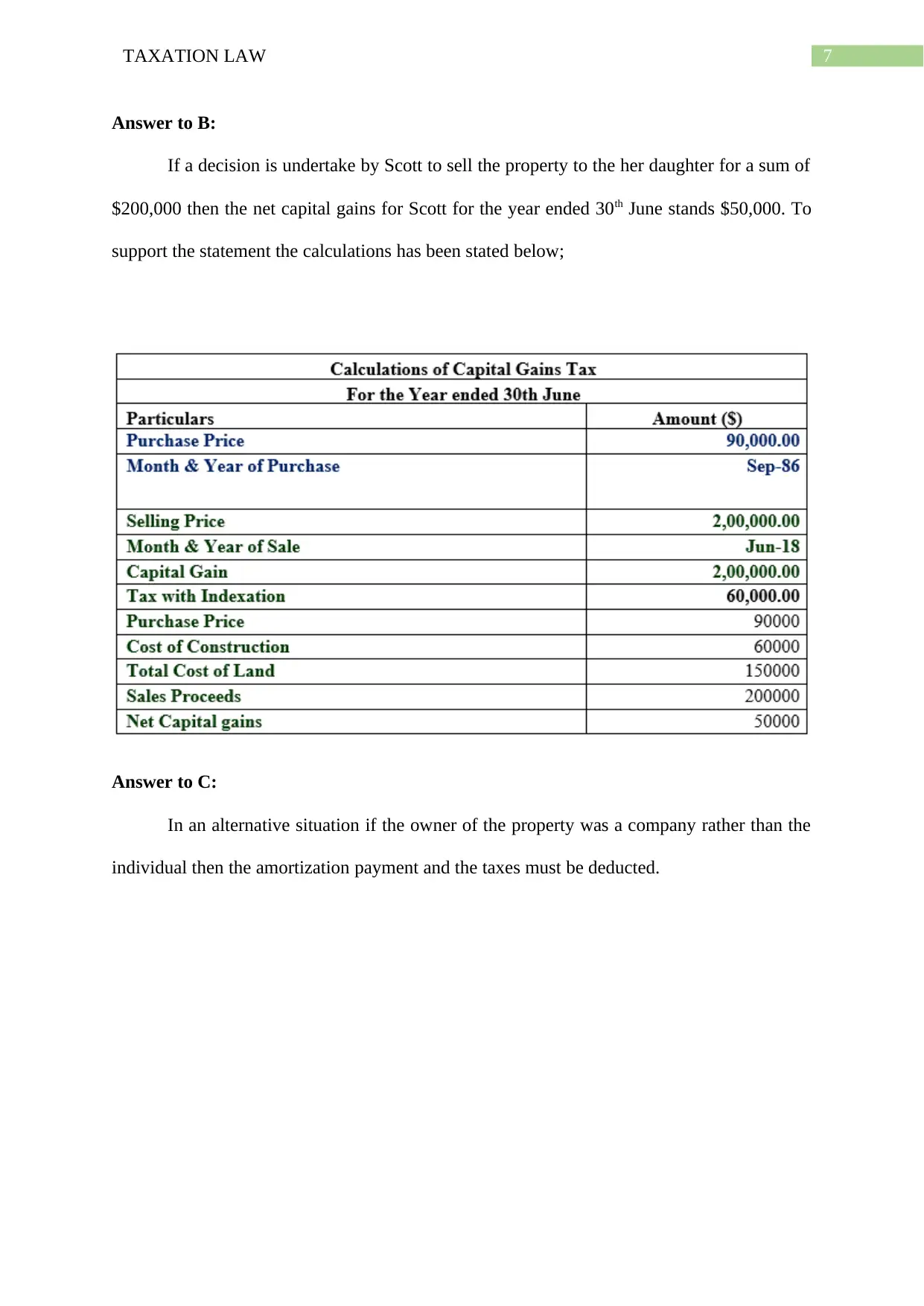
7TAXATION LAW
Answer to B:
If a decision is undertake by Scott to sell the property to the her daughter for a sum of
$200,000 then the net capital gains for Scott for the year ended 30th June stands $50,000. To
support the statement the calculations has been stated below;
Answer to C:
In an alternative situation if the owner of the property was a company rather than the
individual then the amortization payment and the taxes must be deducted.
Answer to B:
If a decision is undertake by Scott to sell the property to the her daughter for a sum of
$200,000 then the net capital gains for Scott for the year ended 30th June stands $50,000. To
support the statement the calculations has been stated below;
Answer to C:
In an alternative situation if the owner of the property was a company rather than the
individual then the amortization payment and the taxes must be deducted.
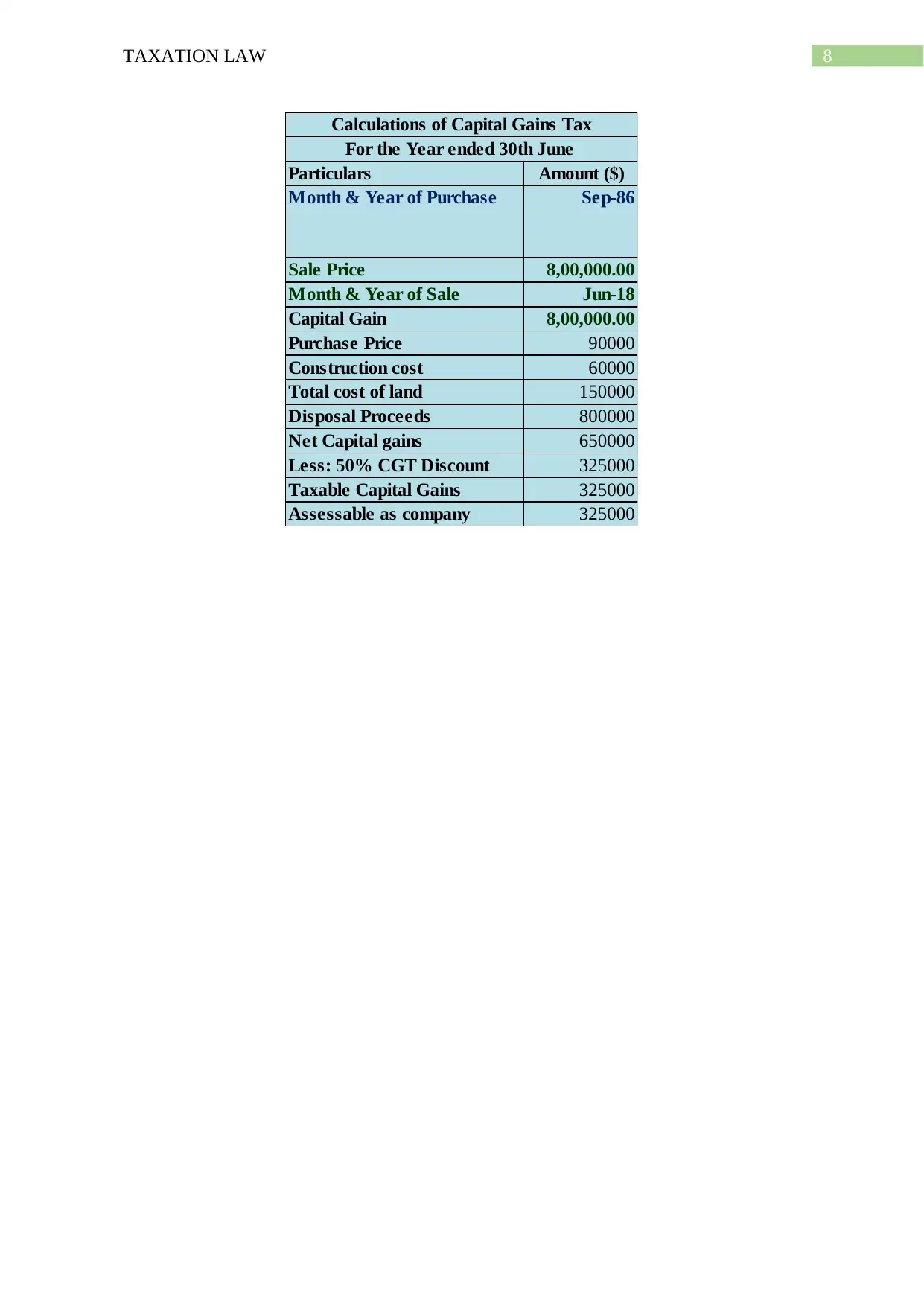
8TAXATION LAW
Particulars Amount ($)
Month & Year of Purchase Sep-86
Sale Price 8,00,000.00
Month & Year of Sale Jun-18
Capital Gain 8,00,000.00
Purchase Price 90000
Construction cost 60000
Total cost of land 150000
Disposal Proceeds 800000
Net Capital gains 650000
Less: 50% CGT Discount 325000
Taxable Capital Gains 325000
Assessable as company 325000
Calculations of Capital Gains Tax
For the Year ended 30th June
Particulars Amount ($)
Month & Year of Purchase Sep-86
Sale Price 8,00,000.00
Month & Year of Sale Jun-18
Capital Gain 8,00,000.00
Purchase Price 90000
Construction cost 60000
Total cost of land 150000
Disposal Proceeds 800000
Net Capital gains 650000
Less: 50% CGT Discount 325000
Taxable Capital Gains 325000
Assessable as company 325000
Calculations of Capital Gains Tax
For the Year ended 30th June
⊘ This is a preview!⊘
Do you want full access?
Subscribe today to unlock all pages.

Trusted by 1+ million students worldwide
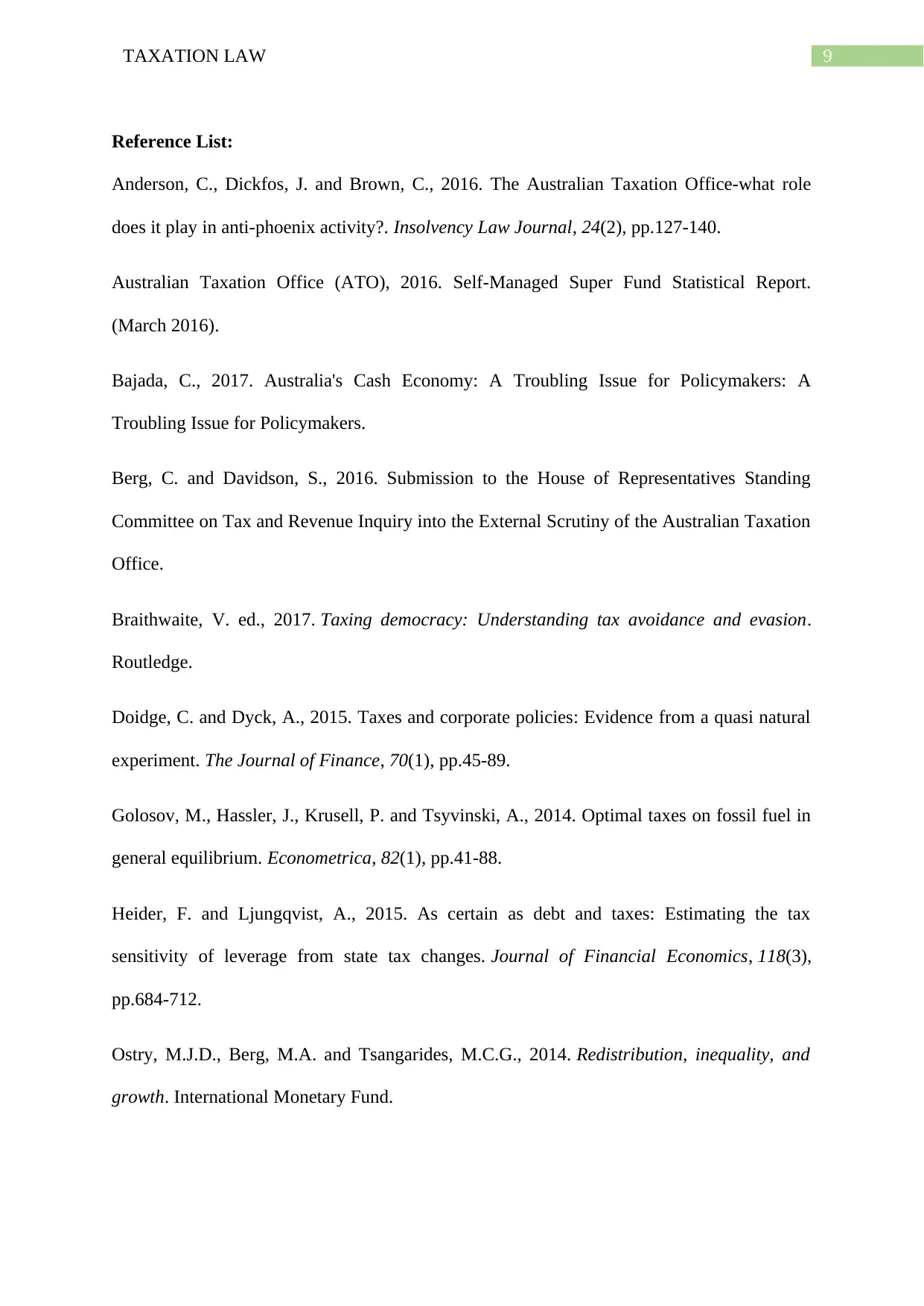
9TAXATION LAW
Reference List:
Anderson, C., Dickfos, J. and Brown, C., 2016. The Australian Taxation Office-what role
does it play in anti-phoenix activity?. Insolvency Law Journal, 24(2), pp.127-140.
Australian Taxation Office (ATO), 2016. Self-Managed Super Fund Statistical Report.
(March 2016).
Bajada, C., 2017. Australia's Cash Economy: A Troubling Issue for Policymakers: A
Troubling Issue for Policymakers.
Berg, C. and Davidson, S., 2016. Submission to the House of Representatives Standing
Committee on Tax and Revenue Inquiry into the External Scrutiny of the Australian Taxation
Office.
Braithwaite, V. ed., 2017. Taxing democracy: Understanding tax avoidance and evasion.
Routledge.
Doidge, C. and Dyck, A., 2015. Taxes and corporate policies: Evidence from a quasi natural
experiment. The Journal of Finance, 70(1), pp.45-89.
Golosov, M., Hassler, J., Krusell, P. and Tsyvinski, A., 2014. Optimal taxes on fossil fuel in
general equilibrium. Econometrica, 82(1), pp.41-88.
Heider, F. and Ljungqvist, A., 2015. As certain as debt and taxes: Estimating the tax
sensitivity of leverage from state tax changes. Journal of Financial Economics, 118(3),
pp.684-712.
Ostry, M.J.D., Berg, M.A. and Tsangarides, M.C.G., 2014. Redistribution, inequality, and
growth. International Monetary Fund.
Reference List:
Anderson, C., Dickfos, J. and Brown, C., 2016. The Australian Taxation Office-what role
does it play in anti-phoenix activity?. Insolvency Law Journal, 24(2), pp.127-140.
Australian Taxation Office (ATO), 2016. Self-Managed Super Fund Statistical Report.
(March 2016).
Bajada, C., 2017. Australia's Cash Economy: A Troubling Issue for Policymakers: A
Troubling Issue for Policymakers.
Berg, C. and Davidson, S., 2016. Submission to the House of Representatives Standing
Committee on Tax and Revenue Inquiry into the External Scrutiny of the Australian Taxation
Office.
Braithwaite, V. ed., 2017. Taxing democracy: Understanding tax avoidance and evasion.
Routledge.
Doidge, C. and Dyck, A., 2015. Taxes and corporate policies: Evidence from a quasi natural
experiment. The Journal of Finance, 70(1), pp.45-89.
Golosov, M., Hassler, J., Krusell, P. and Tsyvinski, A., 2014. Optimal taxes on fossil fuel in
general equilibrium. Econometrica, 82(1), pp.41-88.
Heider, F. and Ljungqvist, A., 2015. As certain as debt and taxes: Estimating the tax
sensitivity of leverage from state tax changes. Journal of Financial Economics, 118(3),
pp.684-712.
Ostry, M.J.D., Berg, M.A. and Tsangarides, M.C.G., 2014. Redistribution, inequality, and
growth. International Monetary Fund.
Paraphrase This Document
Need a fresh take? Get an instant paraphrase of this document with our AI Paraphraser
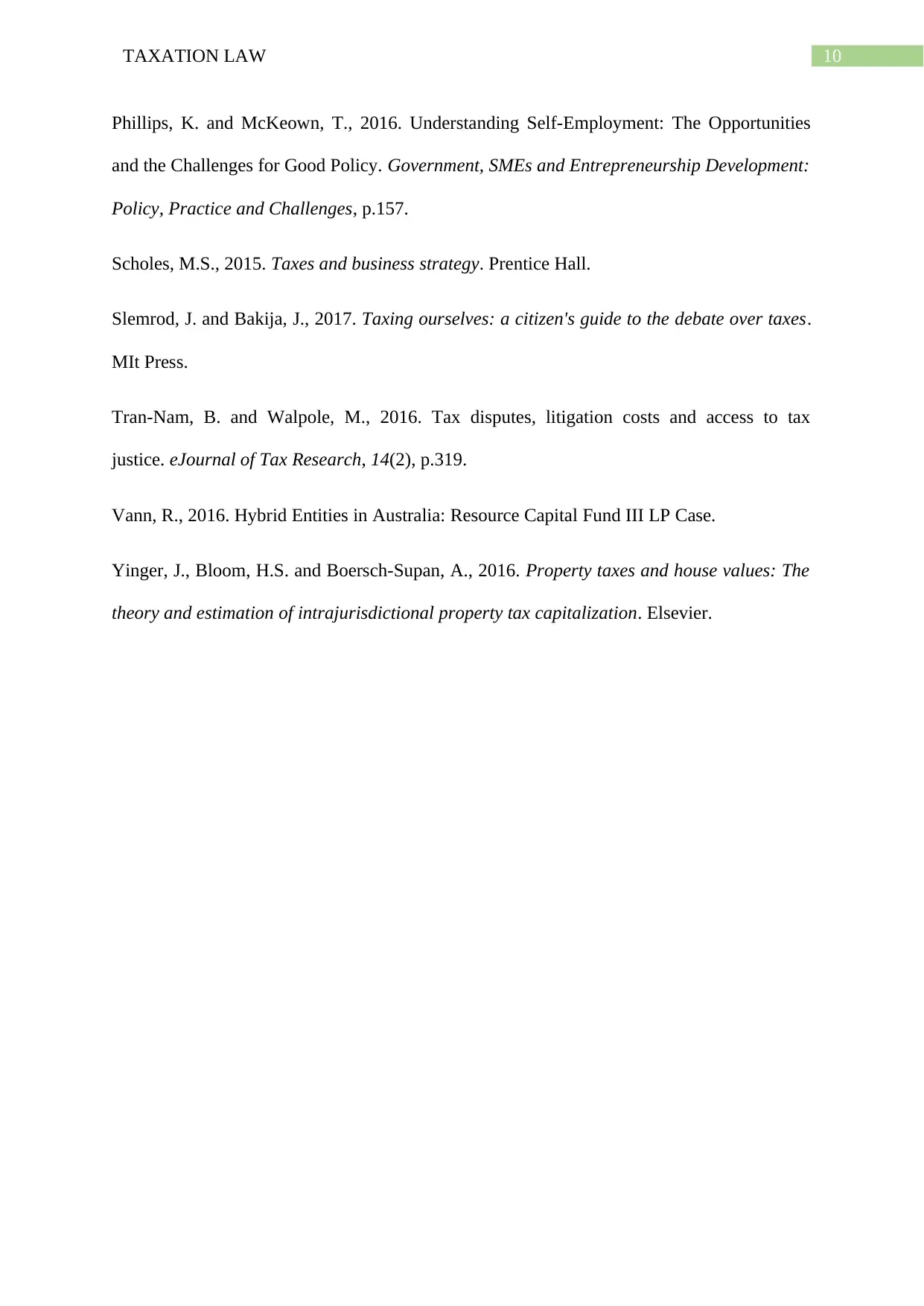
10TAXATION LAW
Phillips, K. and McKeown, T., 2016. Understanding Self-Employment: The Opportunities
and the Challenges for Good Policy. Government, SMEs and Entrepreneurship Development:
Policy, Practice and Challenges, p.157.
Scholes, M.S., 2015. Taxes and business strategy. Prentice Hall.
Slemrod, J. and Bakija, J., 2017. Taxing ourselves: a citizen's guide to the debate over taxes.
MIt Press.
Tran-Nam, B. and Walpole, M., 2016. Tax disputes, litigation costs and access to tax
justice. eJournal of Tax Research, 14(2), p.319.
Vann, R., 2016. Hybrid Entities in Australia: Resource Capital Fund III LP Case.
Yinger, J., Bloom, H.S. and Boersch-Supan, A., 2016. Property taxes and house values: The
theory and estimation of intrajurisdictional property tax capitalization. Elsevier.
Phillips, K. and McKeown, T., 2016. Understanding Self-Employment: The Opportunities
and the Challenges for Good Policy. Government, SMEs and Entrepreneurship Development:
Policy, Practice and Challenges, p.157.
Scholes, M.S., 2015. Taxes and business strategy. Prentice Hall.
Slemrod, J. and Bakija, J., 2017. Taxing ourselves: a citizen's guide to the debate over taxes.
MIt Press.
Tran-Nam, B. and Walpole, M., 2016. Tax disputes, litigation costs and access to tax
justice. eJournal of Tax Research, 14(2), p.319.
Vann, R., 2016. Hybrid Entities in Australia: Resource Capital Fund III LP Case.
Yinger, J., Bloom, H.S. and Boersch-Supan, A., 2016. Property taxes and house values: The
theory and estimation of intrajurisdictional property tax capitalization. Elsevier.
1 out of 11
Related Documents
Your All-in-One AI-Powered Toolkit for Academic Success.
+13062052269
info@desklib.com
Available 24*7 on WhatsApp / Email
![[object Object]](/_next/static/media/star-bottom.7253800d.svg)
Unlock your academic potential
Copyright © 2020–2025 A2Z Services. All Rights Reserved. Developed and managed by ZUCOL.





